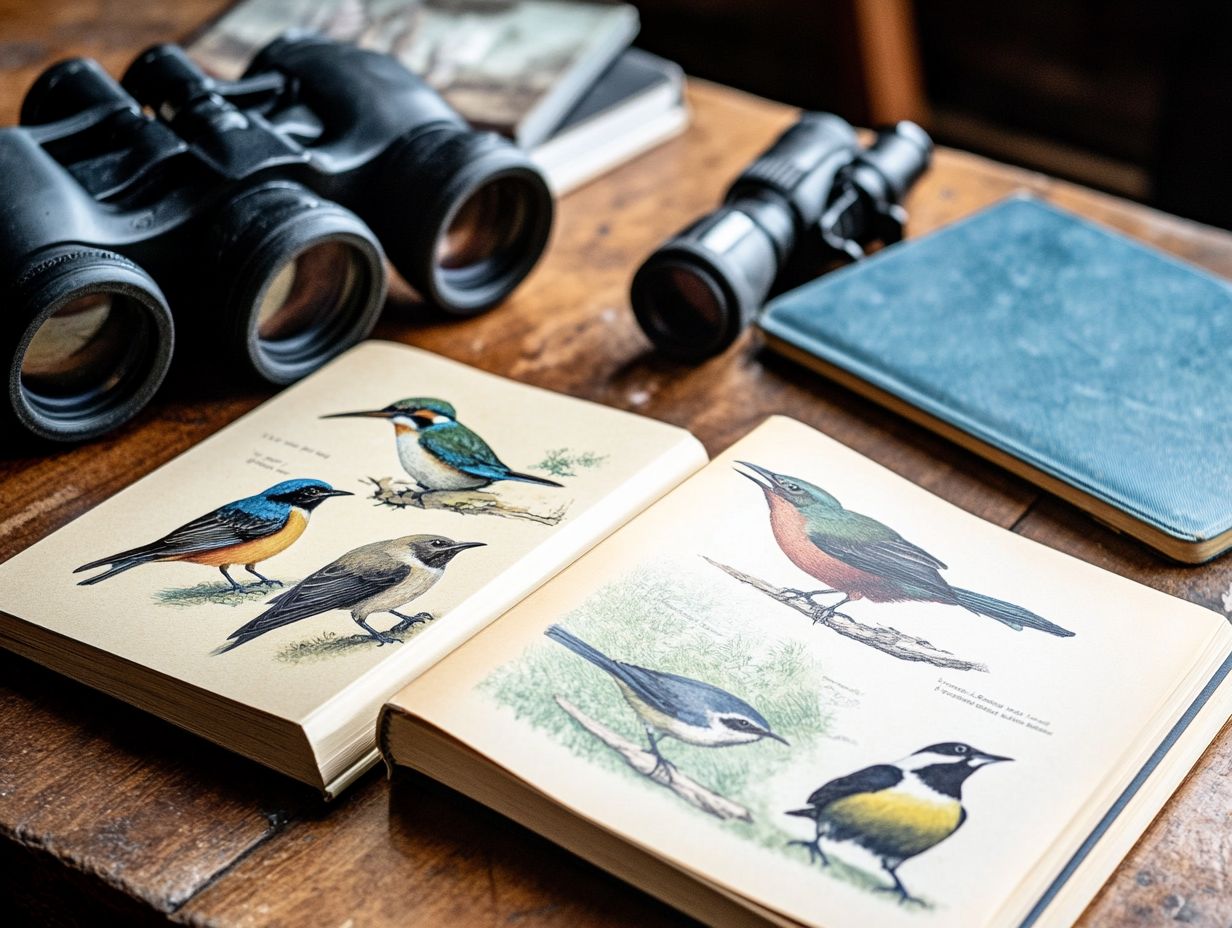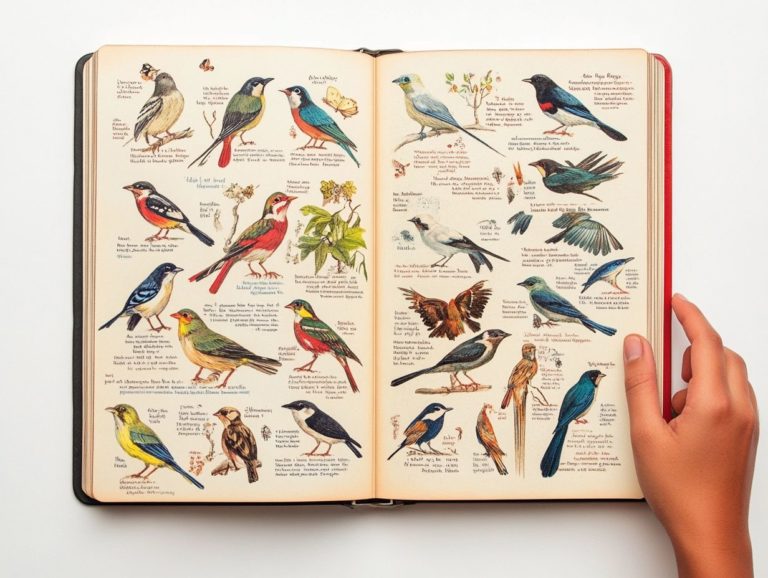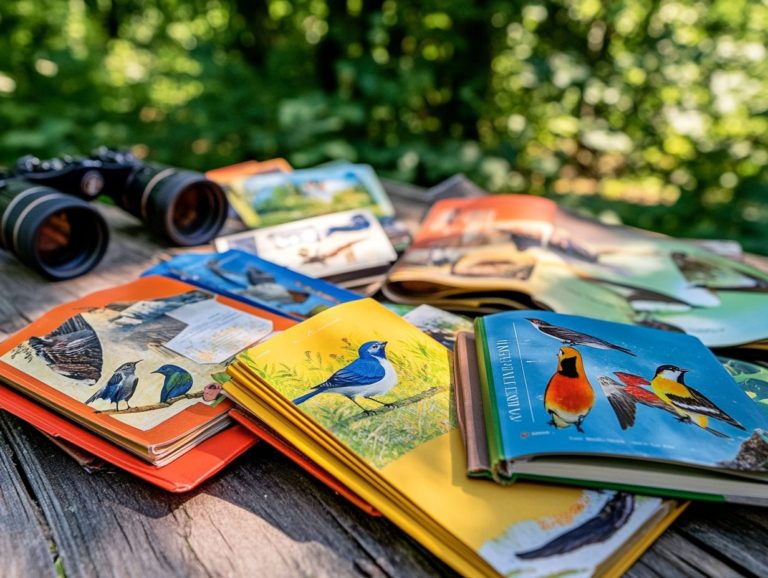Essential Bird Field Guides for the Western U.S.
Birdwatching presents a remarkable opportunity to connect with nature, and possessing the right tools can significantly elevate that experience.
This article delves into essential bird field guides specifically designed for the Western U.S., featuring comprehensive resources like “The Sibley Guide to Birds” alongside specialized references such as “The Shorebird Guide.”
Whether you are just starting out or have been observing birds for years, these guides will aid you in bird identification and truly appreciating the avian marvels that populate this diverse region.
Explore with us as we showcase the finest resources to enhance your birdwatching outdoors adventures.
Contents
- Key Takeaways:
- 1. The Sibley Guide to Birds
- 2. National Geographic Field Guide to the Birds of North America
- 3. The Crossley ID Guide: Eastern Birds
- 4. Kaufman Field Guide to Birds of North America
- 5. Peterson Field Guide to Birds of North America
- 6. Stokes Field Guide to Birds: Eastern Region
- 7. The Warbler Guide
- 8. The Shorebird Guide
- 9. The Hummingbird Book: Your Complete Guide to Attracting, Identifying, and Enjoying Hummingbirds
- 10. Hawks in Flight: Second Edition
- 11. The Crossley ID Guide: Raptors
- 12. Peterson Field Guide to Hawks of North America
- 13. National Geographic Field Guide to the Birds of Western North America
- 14. The Sibley Guide to Bird Life and Behavior
- 15. Birds of the Pacific Northwest: A Timber Press Field Guide
- Frequently Asked Questions
- What are some essential bird field guides for the Western U.S.?
- What makes these bird field guides essential for the Western U.S.?
- Are there any specialized bird field guides for certain regions within the Western U.S.?
- Do these bird field guides have any additional features or resources?
- Can these bird field guides be used by beginners or are they more suitable for experienced birders?
- Are there any other essential bird field guides for the Western U.S. that are not mentioned above?
Key Takeaways:

- The Sibley Guide is a comprehensive and renowned field guide. It is perfect for birders of all levels in the Western North America.
- The National Geographic Field Guide provides in-depth information and stunning illustrations for birds of North America, including those in the Western region.
- The Crossley ID Guide showcases a unique approach to bird identification, specifically focusing on Eastern birds in the Western North America.
1. The Sibley Guide to Birds
The Sibley Guide to Birds stands as a cornerstone resource for your bird identification adventures in North America. It’s celebrated for its detailed drawings and insightful descriptions that cater to both novice and experienced birdwatchers alike.
This guide combines regional insights with easy comparisons of various bird species, making it a critical tool for outdoor enthusiasts like yourself who are keen on birdwatching.
It focuses on critical aspects such as bird songs and behaviors, enriching your experience and deepening your understanding of avian life. The organized visual index enables you to reference quickly, ensuring you can effortlessly identify local species.
With coverage extending to over 800 species from the familiar backyard American Robin to the elusive Barred Owl this guide offers detailed accounts that delve into plumage variations, habitat preferences, and migration patterns.
Its user-friendly layout allows seamless navigation, while the meticulous attention to scientific accuracy distinguishes it from other reference materials.
If you’re exploring specific habitats, the guide provides valuable insights into identifying birds by both sight and sound. This makes it an essential toolkit for every birdwatcher ready to embark on an adventure!
Such features not only foster a deeper connection with avian life but also enable you to engage confidently in your passion for birdwatching.
2. National Geographic Field Guide to the Birds of North America
The National Geographic Field Guide to the Birds of North America is a critical resource for you when it comes to bird identification. It offers detailed insights into various species, highlighting the unique bird species of North America.
This guide features stunning photographs and accurate descriptions, while also emphasizing the significance of understanding bird songs and behaviors making it the perfect companion for both novice birders and seasoned enthusiasts.
Its comprehensive scientific approach enriches your learning experience as you explore the rich diversity of birds across the continent.
What truly distinguishes this field guide is its beautifully illustrated format and meticulously organized content, allowing you to navigate effortlessly through different species.
Unlike other printed guides, it presents high-resolution images alongside intricate details about each bird’s habitat, migration patterns, and fledgling behavior. This aids you in identifying species like the vibrant Indigo Bunting or the elusive Marsh Wren during your outdoor adventures.
The guide also includes audio aids, enabling you to listen to the vocalizations of birds, thus enhancing the auditory aspect of your birdwatching experience. This mix of visuals and sounds is a game-changer for anyone eager to dive deeper into the wonders of birdwatching!
Grab your guide and head outside! Adventure awaits as you discover the fascinating world of birds.
3. The Crossley ID Guide: Eastern Birds
The Crossley ID Guide: Eastern Birds transforms the way you identify birds, offering a fresh perspective on the incredible diversity of avian species in Eastern North America. This specialized guide features breathtaking photographs that allow you to make easy comparisons among similar species. It is an essential companion whether you re a beginner birdwatcher or a seasoned birdwatcher.
Its unique layout showcases birds in their natural habitats, deepening your understanding of how they interact with their environment an essential aspect of birdwatching that enriches your appreciation of nature, especially during migration.
With habitat images and detailed notes on bird songs and behaviors, this guide becomes an invaluable resource, enabling you to not only identify but also truly appreciate the nuances of each species. It caters to all skill levels, allowing you to learn at your own pace.
By harmoniously blending visual appeal with educational content, it equips you with the tools necessary for a fulfilling experience in the great outdoors. Ultimately, it makes birding more accessible and enjoyable for everyone across North America.
4. Kaufman Field Guide to Birds of North America
The Kaufman Field Guide to Birds of North America is your go-to tool for bird identification. It boasts a user-friendly layout that makes it a breeze to compare bird species across the continent. It is considered one of the best books for bird enthusiasts.
Its concise organization allows you to quickly grasp the characteristics of various birds, catering to everyone from beginners to bird scientists. You ll love how it highlights side-by-side comparisons to help you spot differences quickly in size, coloration, and markings. This enables you to easily distinguish between similar species like the Eastern and Western Bluebird.
Featuring over 650 bird species, this guide ensures you ll encounter familiar sights, such as the majestic Bald Eagle and the vibrant American Robin. Each page of the Kaufman Field Guide nurtures your confidence and curiosity, leading you through the rich avian landscape of North America.
5. Peterson Field Guide to Birds of North America

The Peterson Field Guide to Birds of North America is often regarded as one of the finest resources for bird identification. It is celebrated for its innovative techniques and intricately detailed illustrations that appeal to both newcomers and experienced birdwatchers.
This guide categorizes species in a way that makes it easy for you to grasp the rich avian diversity across North America. With its practical approach and scientifically accurate illustrations, it s essential for anyone eager to improve their birdwatching skills.
Its historical significance lies in its transformation of bird identification, moving away from text-heavy descriptions to a visually-driven approach for the visual learner. The guide features user-friendly elements, like an organized index and vibrant illustrations, allowing novice birders to swiftly locate specific species without feeling overwhelmed.
By bridging the gap between detailed scientific information and accessible education, it enables you to explore your local habitats with confidence. This makes the joy of birdwatching accessible to a broader audience, including John James Audubon enthusiasts.
Get your guides today and start your birdwatching adventure!
6. Stokes Field Guide to Birds: Eastern Region
The Stokes Field Guide to Birds: Eastern Region serves as your ultimate companion for enhancing bird identification. This guide is specifically tailored to the unique avian life in Eastern North America. It combines intricate illustrations with informative text that highlights key traits, including bird songs, behaviors, and habitats. It’s an invaluable resource for both novice birders and seasoned birdwatchers alike.
The Stokes approach creates an interactive learning experience, enabling you to effectively identify and appreciate the rich diversity of birds around you.
As you explore, the guide presents a captivating array of visuals paired with concise descriptions. It encourages you to venture outdoors and observe common species like the Eastern Bluebird and the Red-tailed Hawk. You ll also discover distinctive bird calls, offering a fascinating way to tune into the sounds that define your environment.
This engaging approach not only aids in identification but also deepens your understanding of bird behavior, particularly during migration seasons. It is essential for birdwatching outdoors.
With practical tips and compelling narratives about local biodiversity, the Stokes Field Guide invites you to fully immerse yourself in the vibrant world of Eastern North American birds. It provides insights that enhance your birdwatching experience.
7. The Warbler Guide
The Warbler Guide serves as your authoritative resource for identifying warblers. It provides a detailed guide that deepens your understanding of these vibrant and diverse birds found throughout North America. This guide beautifully combines detailed illustrations with audio resources, creating an immersive experience that helps you recognize bird songs.
Whether you re just starting your birding journey or you ve been watching birds for years, The Warbler Guide enriches your appreciation for these captivating avian species.
By focusing specifically on this family of birds, the guide enhances your experience as you identify a range of warblers, from the striking Yellow Warbler to the elusive Black-throated Blue Warbler. Each thrives in unique ecosystems from dense forests to coastal regions. With high-quality audio files at your fingertips, you can listen to the subtle differences in song patterns, making it easier to distinguish between species while out in the field.
The guide also offers valuable insights into their preferred habitats, feeding behaviors, and the routes birds take during seasonal changes. It is an essential tool for anyone eager to refine their birdwatching skills and cultivate a deeper connection to nature.
8. The Shorebird Guide
The Shorebird Guide is a critical resource for you when it comes to bird identification. It specifically hones in on the diverse and often elusive shorebirds that grace the landscapes of North America. This specialized guide opens up a world of detailed information and comparisons among various species, making it essential for your outdoor birdwatching adventures.
With a focus on habitat and behavior, The Shorebird Guide enables both novice birders and seasoned enthusiasts like yourself to elevate your understanding and appreciation of these remarkable birds.
Identifying shorebirds can be a unique challenge, especially due to their similar physical characteristics and the different feather appearances birds have in various seasons. This guide truly shines with its meticulously organized sections, showcasing side-by-side comparisons that emphasize key identifying traits such as beak shape, leg length, and coloration patterns.
For example, it delves into notable species like the elegant Black-necked Stilt and the striking Red Knot, highlighting their distinct habitat preferences and migratory behaviors. By incorporating vivid photographs and practical tips for spotting these birds in various coastal environments, this guide becomes invaluable for anyone looking to enrich their outdoor birdwatching experience.
Get ready to explore the vibrant world of birds!
9. The Hummingbird Book: Your Complete Guide to Attracting, Identifying, and Enjoying Hummingbirds
The Hummingbird Book is your ultimate guide to attracting, identifying, and reveling in the enchanting world of hummingbirds. Whether you re a novice or an experienced birdwatcher, this resource is packed with invaluable insights.
It explores the unique traits of various hummingbird species found in North America and offers detailed advice on luring these remarkable birds into your outdoor spaces. With practical tips and stunning illustrations, The Hummingbird Book elevates your birdwatching experience, especially if you re eager to learn more about these captivating avians.
The guide is thoughtfully organized, emphasizing effective strategies like using specially designed feeders filled with natural nectar. It also highlights selecting a variety of native plants that bloom during key seasons.
These methods not only invite hummingbirds to visit but also help you forge a deeper connection with nature. With easy-to-follow identification tips, distinguishing between species becomes a breeze. The hands-on activities inspire you to engage actively with your environment.
This approach enriches your outdoor experiences and deepens your appreciation for these astonishing creatures.
10. Hawks in Flight: Second Edition

“Hawks in Flight: Second Edition” is your go-to guide for identifying hawks as they migrate across North America. It offers practical insights and techniques that elevate your outdoor birdwatching experience.
This specialized resource highlights the unique characteristics of various hawk species, helping you recognize them in flight a vital skill for any serious birdwatcher.
With detailed illustrations and informative text, “Hawks in Flight” enables you, whether you’re a beginner or a seasoned enthusiast, to significantly enhance your bird identification skills.
The guide stands out with its structured approach to educating you on how to distinguish between similar species. It zeroes in on critical features like wing shape, flight patterns, and behavioral traits.
For example, you can learn to differentiate between the sharp-shinned hawk and Cooper’s hawk by observing their contrasting profiles while soaring. It includes migration maps and seasonal notes, making it critical for tracking species such as the Broad-winged Hawk or the Red-tailed Hawk on their remarkable journeys.
The clever combination of practical tips and vivid imagery transforms your outdoor birdwatching into an enriching experience. You’ll fully appreciate the wonder of avian migration!
11. The Crossley ID Guide: Raptors
The Crossley ID Guide: Raptors offers you an innovative approach to bird identification, focusing on the fascinating array of raptors found throughout North America. This specialized guide is packed with stunning visuals and interactive layouts, enabling you to effectively compare and identify various raptor species in their natural habitats.
Whether you’re a novice birdwatcher or a seasoned enthusiast, this guide elevates your outdoor experience by highlighting the behaviors and roles in nature of these majestic birds of prey.
With detailed photographs and comparative illustrations, you can engage with the material intuitively. This fosters a deeper understanding of raptor identification and behavior.
The guide doesn t just capture the physical traits of these birds; it also delves into their hunting techniques, nesting habits, and migration patterns. These insights help you understand how raptors fit into their environments and maintain balance in nature.
This thoughtfully crafted guide is an essential resource for anyone passionate about observing and protecting these remarkable creatures. Discover the thrill of birdwatching!
12. Peterson Field Guide to Hawks of North America
The Peterson Field Guide to Hawks of North America serves as your definitive resource for identifying hawks.
It elegantly showcases the diverse species that inhabit the continent through clear illustrations and precise scientific descriptions.
Its practical applications go beyond simple identification. It provides you with a deeper understanding of hawk behaviors and their preferred habitats.
Within this comprehensive guide, you ll find detailed range maps and seasonal variations, helping you find out where and when to see certain hawk species.
It also offers fascinating insights into their feeding habits and social interactions. This enriches your appreciation for these magnificent birds and their essential roles within ecosystems.
For beginners, this information is invaluable. It sets the stage for meaningful birdwatching experiences and encourages thoughtful, informed engagement with the natural world.
13. National Geographic Field Guide to the Birds of Western North America
The National Geographic Field Guide to the Birds of Western North America is a critical resource for your bird identification journey, especially when paired with top field guides for birding in national parks.
It focuses on the diverse species that call this unique region home. This guide marries stunning visuals with detailed descriptions, making it an exceptional choice whether you’re a novice birder or a seasoned birdwatcher eager to explore popular bird field guides among experienced birders and delve into the avian wonders of the West.
With a keen emphasis on regional specialties and habitats, it elevates your understanding and appreciation of the birds that adorn Western North America. For those looking to enhance their birding experience, consulting the top field guides for coastal birding adventures makes it a must-have for any outdoor enthusiast.
This guide catalogs many bird species in detail, from the majestic Bald Eagle soaring over coastal cliffs to the vibrant Western Tanager flitting among the conifers, making it one of the most useful field guides for travel birding.
Each entry highlights key identification features, such as plumage color, song patterns, and behavioral traits, making it easy for you to recognize these birds in the field.
It also explores the ecological importance of various habitats. This illumination of how these birds interact with their surroundings and adapt to regional climates enhances your birdwatching experience.
Understanding these factors deepens your respect for conservation efforts dedicated to protecting these remarkable avian communities.
14. The Sibley Guide to Bird Life and Behavior
The Sibley Guide to Bird Life and Behavior offers you a deep dive into the fascinating world of avian species.
It explores their unique behaviors and ecological roles throughout North America. This guide elevates your bird identification skills by revealing how different birds engage with their environments insights that are invaluable for any birdwatcher looking to enrich their understanding of avian life.
With clear illustrations and detailed descriptions, the Sibley Guide becomes your essential companion, whether you re just starting out or are a seasoned enthusiast seeking to enhance your birdwatching adventures.
By honing in on specific behaviors like courtship displays, foraging techniques, and migratory patterns, the guide equips you with critical clues for identifying species.
For example, spotting the undulating flight of a meadowlark or the playful tree-hopping of a chickadee can be key to accurately recognizing them.
The guide also delves into behaviors such as vocalizations and nesting habits, showing how these traits can serve as markers for distinguishing similar-looking species.
This treasure trove of information equips you with the skills to explore avian life like never before! It transforms each birdwatching outing into an engaging learning experience.
15. Birds of the Pacific Northwest: A Timber Press Field Guide

The Birds of the Pacific Northwest: A Timber Press Field Guide is your must-have companion for bird identification. This rich environment showcases a stunning variety of birds that will enchant both new and seasoned birders, making field guides essential for every birdwatcher.
With exquisite illustrations and insightful descriptions, you ll easily recognize local bird species in their natural settings.
By focusing on specific ecosystems from coastal shorelines to lush forests this guide encourages you to explore diverse habitats. You ll boost your chances of spotting remarkable birds like the striking Harlequin Duck and the elusive Great Horned Owl.
It offers tips on identifying birds throughout the seasons, showing how migration affects which species you might see. This approach sharpens your identification skills and deepens your connection with the natural world.
Frequently Asked Questions
What are some essential bird field guides for the Western U.S.?
Some essential bird field guides for the Western U.S. include “The Sibley Guide to Birds” by David Allen Sibley, “National Geographic Field Guide to the Birds of Western North America” by Jon L. Dunn and Jonathan Alderfer, and regional bird field guides you need to own like “Birds of the Pacific Northwest” by Tom Aversa, Richard Cannings, and Hal Opperman.
What makes these bird field guides essential for the Western U.S.?
These bird field guides are essential for the Western U.S. because they contain comprehensive information on a wide variety of bird species commonly found in this region. For those interested in Eastern U.S. birds, check out the must-have field guides that also include detailed range maps and accurate illustrations to aid in identification.
Are there any specialized bird field guides for certain regions within the Western U.S.?
Yes, there are specialized bird field guides for certain regions within the Western U.S. For example, “Birds of the Sierra Nevada” by Edward C. Beedy and Edward R. Pandolfino focuses specifically on birds found in the Sierra Nevada mountains, while “Birds of the Rocky Mountains” by Ted Floyd covers bird species in the Rocky Mountains region. For those looking for a broader selection, check out the most comprehensive bird field guides available.
Do these bird field guides have any additional features or resources?
Many of these bird field guides also include information on bird behavior, habitat, and conservation status. Some come with digital versions or accompanying apps for quick and easy identification in the field.
Can these bird field guides be used by beginners or are they more suitable for experienced birders?
These bird field guides can be used by both beginners and experienced birders. They provide detailed information and illustrations that benefit novice birders while also being comprehensive enough to satisfy the needs of experienced birders.
Are there any other essential bird field guides for the Western U.S. that are not mentioned above?
There are several other essential bird field guides for the Western U.S. that are not mentioned above, such as “The Crossley ID Guide: Western Birds” by Richard Crossley and “Birds of the American Southwest” by John H. Rappole. Additionally, exploring the best bird field guides for coastal regions is recommended to research and compare different guides to find the best fit for individual needs and preferences.






